Hyundai’s Ioniq 5 nods to past while pushing toward EVs future
New York Times
last updated: Apr 11,2022

One look at the charming Hyundai Ioniq 5 reliably spawns another. A weeklong
drive suggests that Hyundai Motor may be a real dark horse in electric vehicles
(EVs)— if it can find enough batteries and factory capacity to put EVs in
showrooms from coast to coast.اضافة اعلان
With its origami body, spunky performance, luxury-level tech, and some of the fastest charging in the game, Hyundai’s little knockout could further propel the South Korean juggernaut that sold nearly 1.5 million cars in the US last year. Throw in high-design models from its Genesis luxury brand, and the company has hogged industry awards and headlines like no mainstream automaker in recent years. Headlines include habitual poaching of star designers and engineers from respected brands such as Bentley, Audi, and BMW. They include Sangyup Lee, Hyundai Motor’s global design chief, who previously worked at Bentley and Volkswagen.
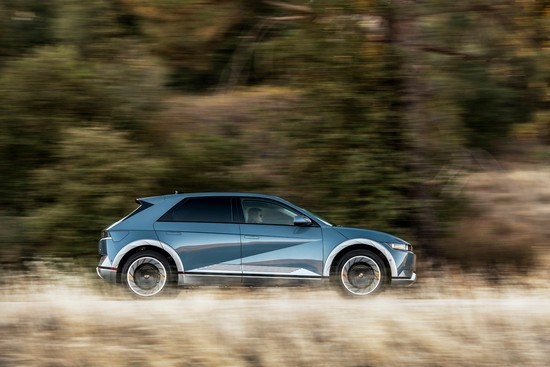
The South Korean rise echoes that of Japanese automakers beginning a half-century ago, when brands like Toyota and Honda just seemed hungrier and nimbler than the competition from Detroit or Europe. Here in 2022, all three Hyundai brands also remain strongly committed to cars, including sedans that Detroit virtually abandoned in favor of more profitable SUVs and pickups. Even before the pandemic and soaring gasoline prices, Hyundai executives cited fuel-efficient cars and hybrids as a smart long-term play, in part to keep car loyalists and lure new ones from SUV-only brands.
The Ioniq 5 is officially a crossover SUV, but it is essentially a taller hatchback with available all-wheel-drive. Its targets are the Tesla Model Y, Ford Mustang Mach-E, Volkswagen ID.4, and Nissan Ariya. For cognoscenti, the Ioniq 5’s faceted surfaces are delightful callbacks to cars by Giorgetto Giugiaro of Italy, one of the 20th century’s top auto designers — especially his 1970s and ’80s oeuvre, such as the Lancia Delta, Lotus Esprit (007’s favorite underwater sports car), Saab 9000, and Volkswagen Scirocco.
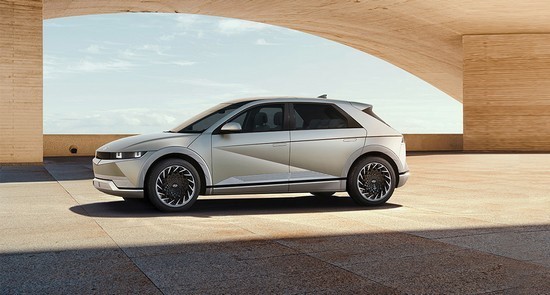
“He was a maestro in this industry,” said Lee, who fondly recalls chatting with Giugiaro earlier in his career. Giugiaro also designed the Hyundai Pony, South Korea’s first broadly exported car.
“In the early ’70s, there was no car culture here in Korea, so they started a car company out of nothing,” Lee said.
The Ioniq 5 says “Hello, Future” in unmistakable terms, yet avoids the gimmicks and trendiness that mar some EVs. They include its Kia EV6 sister car, whose electric-rocketship vibe may not wear as well, and dings both rear headroom and cargo space. The Hyundai is a car that will still look good 10 or 20 years from today.
“The ultimate goal of design is to be timeless,” said Lee, who sees the Ioniq as a common thread in Hyundai’s evolution. “Why not take the Pony as inspiration, but then take it to the future?”
An Audi-esque clamshell hood drapes elegantly over the Ioniq 5’s front fenders. Signature, pixelated lighting flashes blocks of LEDs from headlamps and taillamps, recalling Tetris and other vintage 8-bit video games. Optional 20-inch alloy wheels in a kaleidoscope pattern are pulled to the corners, muscular visual bookends for a massive 118-inch wheelbase. That wheelbase stretches 4 inches beyond that of Hyundai’s largest SUV, the three-row Palisade, aiding an absorbent ride and roomy back seat.
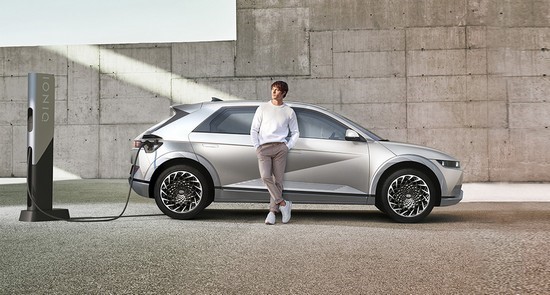
The 39.4 inches of rear legroom is within 1 inch of the class-leading Tesla’s, despite the Hyundai’s being 4 inches shorter overall, and nearly 3 more inches than a fossil-fueled Mercedes-Benz GLC SUV. While we are back there, the Hyundai’s most glaring omission is a rear wiper for its steeply canted rear glass.
Compared with the bravura exterior, the interior hews closer to familiar EV tropes. But it is still a nice place to be, thanks to Hyundai’s usual overachieving in materials, well-considered details, and unexpected features. The brand’s first head-up display integrates augmented reality directional guides.
A pair of 12-inch screens perch like desktop monitors above a slim dashboard, flashing sharply rendered, configurable driver displays, and a fine navigation system with intuitive voice controls. Hyundai’s semi-autonomous driver-assistance tech, including adaptive cruise control, can steer the Ioniq 5 down its lane with luxury-level confidence, easing stress in long drives or traffic snarls. That system integrates machine learning that studies a driver’s behavior to adjust acceleration and distance from other cars.
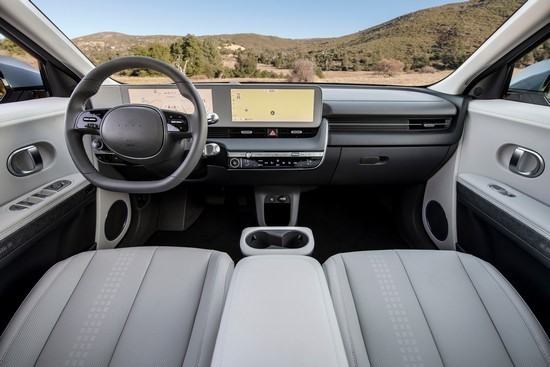
The Ioniq is the first of up to 23 global models on Hyundai’s new Electric Global Modular Platform through 2025. They include the Kia EV6 SUV, which is already on sale, and a sleek Genesis GV60 later this year. That skateboard layout packages its entire 77.4 kilowatt-hour (kWh)battery between the axles for more-planted performance. And the Ioniq 5’s hushed cabin, supple ride and charming road manners offered a hopeful taste of what is to come. I drove a top-shelf Ioniq 5 Limited AWD priced at $55,725, or $48,225 after a $7,500 federal credit.
A rear-drive Ioniq 5 squeezes 490km of range and a frugal 114 mpge from a 225-horsepower electric motor for $44,875 to start. A $3,500 upcharge boosts traction and velocity with dual-motor all-wheel drive. After tax breaks, those AWD versions can be had for around $41,000 to $43,000, well below the current average new-car price of about $47,000.
With 320 horsepower, the Hyundai whispered to 60 mph in about 4.5 seconds, making short work of even muscled-up gasoline SUVs. The trade-off for all-wheel-drive power and traction is a shorter 256-mile range and 98-mpge rating; Tesla’s stingiest Model Y does better at around 530km and 122 mpge. The Hyundai does top the comparable Mach-E’s 90 mpge. In bitter January temperatures, that range fell closer to around 360km, no matter how I babied the throttle or dialed back on cabin temps. In more-favorable conditions, I am confident I could squeeze around 435km from this plug-in cutie, more than enough for owners who recharge daily.
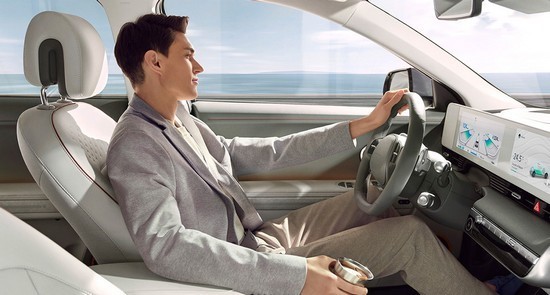
The suspension is more cushy than sporty, and as with most EVs, the steering does not transmit much feel for the road. Yet that steering is smoothly weighted and quick, without being darty as in the Model Y. With proper encouragement, the Hyundai is surprisingly frisky.
Sophisticated regenerative braking encapsulates the engineering prowess. A generous five regen levels, selectable via paddle shifters, range from a coast mode to the strongest “iPedal” setting. The latter elicits effortless stops as you ease off the throttle, for the one-pedal driving many EV disciples swear by. The physical brake pedal itself can feel spongy, and a sport mode exclusively for brakes dials up firmer response.
Ultrafast public charging may be the biggest technical coup, making these Hyundai models serious road trippers. At its best, the Ioniq 5 can stuff its battery from 10 percent to 80 percent full in just 18 minutes — not quite gas-pump-fast, but plenty for interstate quick-draws. A five-minute charge adds up to around 110km. The secret sauce is a robust 800-volt battery architecture, matching six-figure electric speedsters from Porsche and Audi and doubling Tesla’s 400 volts.
For home or office, the Hyundai’s 10.9-kilowatt onboard AC charger also allows a faster-than-usual Level 2 refill, reaching 100 percent charge in six hours and 43 minutes. A vehicle-to-load (V2L) function lets owners charge e-bikes, outdoor gear, electronics and even other EVs from the Hyundai’s battery.
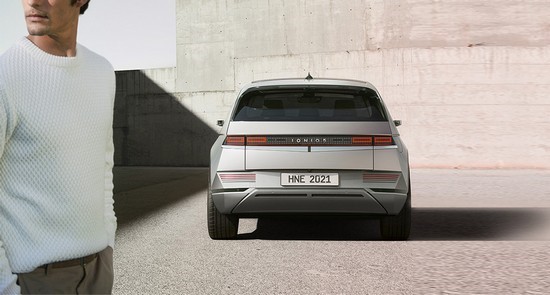
Like Ford’s Mach-E, this Hyundai may push the buttons for buyers who are ready to go electric but are not into Tesla or its polarizing CEO. Hyundai plans to kick off US EV production this year, with an as-yet-unknown model.
Like most global automakers that rely on lithium-ion batteries, Hyundai faces daunting supply issues that may only get worse until companies can bring a multibillion-dollar wave of EV and battery factories online.
Unusually for Hyundai though, the Ioniq 5 went on sale in Europe before its home nation, to focus limited production in that red-hot EV market and satisfy more pressing regulatory rules.
Read more Drive
Jordan News
With its origami body, spunky performance, luxury-level tech, and some of the fastest charging in the game, Hyundai’s little knockout could further propel the South Korean juggernaut that sold nearly 1.5 million cars in the US last year. Throw in high-design models from its Genesis luxury brand, and the company has hogged industry awards and headlines like no mainstream automaker in recent years. Headlines include habitual poaching of star designers and engineers from respected brands such as Bentley, Audi, and BMW. They include Sangyup Lee, Hyundai Motor’s global design chief, who previously worked at Bentley and Volkswagen.

The South Korean rise echoes that of Japanese automakers beginning a half-century ago, when brands like Toyota and Honda just seemed hungrier and nimbler than the competition from Detroit or Europe. Here in 2022, all three Hyundai brands also remain strongly committed to cars, including sedans that Detroit virtually abandoned in favor of more profitable SUVs and pickups. Even before the pandemic and soaring gasoline prices, Hyundai executives cited fuel-efficient cars and hybrids as a smart long-term play, in part to keep car loyalists and lure new ones from SUV-only brands.
The Ioniq 5 is officially a crossover SUV, but it is essentially a taller hatchback with available all-wheel-drive. Its targets are the Tesla Model Y, Ford Mustang Mach-E, Volkswagen ID.4, and Nissan Ariya. For cognoscenti, the Ioniq 5’s faceted surfaces are delightful callbacks to cars by Giorgetto Giugiaro of Italy, one of the 20th century’s top auto designers — especially his 1970s and ’80s oeuvre, such as the Lancia Delta, Lotus Esprit (007’s favorite underwater sports car), Saab 9000, and Volkswagen Scirocco.

“He was a maestro in this industry,” said Lee, who fondly recalls chatting with Giugiaro earlier in his career. Giugiaro also designed the Hyundai Pony, South Korea’s first broadly exported car.
“In the early ’70s, there was no car culture here in Korea, so they started a car company out of nothing,” Lee said.
The Ioniq 5 says “Hello, Future” in unmistakable terms, yet avoids the gimmicks and trendiness that mar some EVs. They include its Kia EV6 sister car, whose electric-rocketship vibe may not wear as well, and dings both rear headroom and cargo space. The Hyundai is a car that will still look good 10 or 20 years from today.
“The ultimate goal of design is to be timeless,” said Lee, who sees the Ioniq as a common thread in Hyundai’s evolution. “Why not take the Pony as inspiration, but then take it to the future?”
An Audi-esque clamshell hood drapes elegantly over the Ioniq 5’s front fenders. Signature, pixelated lighting flashes blocks of LEDs from headlamps and taillamps, recalling Tetris and other vintage 8-bit video games. Optional 20-inch alloy wheels in a kaleidoscope pattern are pulled to the corners, muscular visual bookends for a massive 118-inch wheelbase. That wheelbase stretches 4 inches beyond that of Hyundai’s largest SUV, the three-row Palisade, aiding an absorbent ride and roomy back seat.

The 39.4 inches of rear legroom is within 1 inch of the class-leading Tesla’s, despite the Hyundai’s being 4 inches shorter overall, and nearly 3 more inches than a fossil-fueled Mercedes-Benz GLC SUV. While we are back there, the Hyundai’s most glaring omission is a rear wiper for its steeply canted rear glass.
Compared with the bravura exterior, the interior hews closer to familiar EV tropes. But it is still a nice place to be, thanks to Hyundai’s usual overachieving in materials, well-considered details, and unexpected features. The brand’s first head-up display integrates augmented reality directional guides.
A pair of 12-inch screens perch like desktop monitors above a slim dashboard, flashing sharply rendered, configurable driver displays, and a fine navigation system with intuitive voice controls. Hyundai’s semi-autonomous driver-assistance tech, including adaptive cruise control, can steer the Ioniq 5 down its lane with luxury-level confidence, easing stress in long drives or traffic snarls. That system integrates machine learning that studies a driver’s behavior to adjust acceleration and distance from other cars.

The Ioniq is the first of up to 23 global models on Hyundai’s new Electric Global Modular Platform through 2025. They include the Kia EV6 SUV, which is already on sale, and a sleek Genesis GV60 later this year. That skateboard layout packages its entire 77.4 kilowatt-hour (kWh)battery between the axles for more-planted performance. And the Ioniq 5’s hushed cabin, supple ride and charming road manners offered a hopeful taste of what is to come. I drove a top-shelf Ioniq 5 Limited AWD priced at $55,725, or $48,225 after a $7,500 federal credit.
A rear-drive Ioniq 5 squeezes 490km of range and a frugal 114 mpge from a 225-horsepower electric motor for $44,875 to start. A $3,500 upcharge boosts traction and velocity with dual-motor all-wheel drive. After tax breaks, those AWD versions can be had for around $41,000 to $43,000, well below the current average new-car price of about $47,000.
With 320 horsepower, the Hyundai whispered to 60 mph in about 4.5 seconds, making short work of even muscled-up gasoline SUVs. The trade-off for all-wheel-drive power and traction is a shorter 256-mile range and 98-mpge rating; Tesla’s stingiest Model Y does better at around 530km and 122 mpge. The Hyundai does top the comparable Mach-E’s 90 mpge. In bitter January temperatures, that range fell closer to around 360km, no matter how I babied the throttle or dialed back on cabin temps. In more-favorable conditions, I am confident I could squeeze around 435km from this plug-in cutie, more than enough for owners who recharge daily.

The suspension is more cushy than sporty, and as with most EVs, the steering does not transmit much feel for the road. Yet that steering is smoothly weighted and quick, without being darty as in the Model Y. With proper encouragement, the Hyundai is surprisingly frisky.
Sophisticated regenerative braking encapsulates the engineering prowess. A generous five regen levels, selectable via paddle shifters, range from a coast mode to the strongest “iPedal” setting. The latter elicits effortless stops as you ease off the throttle, for the one-pedal driving many EV disciples swear by. The physical brake pedal itself can feel spongy, and a sport mode exclusively for brakes dials up firmer response.
Ultrafast public charging may be the biggest technical coup, making these Hyundai models serious road trippers. At its best, the Ioniq 5 can stuff its battery from 10 percent to 80 percent full in just 18 minutes — not quite gas-pump-fast, but plenty for interstate quick-draws. A five-minute charge adds up to around 110km. The secret sauce is a robust 800-volt battery architecture, matching six-figure electric speedsters from Porsche and Audi and doubling Tesla’s 400 volts.
For home or office, the Hyundai’s 10.9-kilowatt onboard AC charger also allows a faster-than-usual Level 2 refill, reaching 100 percent charge in six hours and 43 minutes. A vehicle-to-load (V2L) function lets owners charge e-bikes, outdoor gear, electronics and even other EVs from the Hyundai’s battery.

Like Ford’s Mach-E, this Hyundai may push the buttons for buyers who are ready to go electric but are not into Tesla or its polarizing CEO. Hyundai plans to kick off US EV production this year, with an as-yet-unknown model.
Like most global automakers that rely on lithium-ion batteries, Hyundai faces daunting supply issues that may only get worse until companies can bring a multibillion-dollar wave of EV and battery factories online.
Unusually for Hyundai though, the Ioniq 5 went on sale in Europe before its home nation, to focus limited production in that red-hot EV market and satisfy more pressing regulatory rules.
Read more Drive
Jordan News

